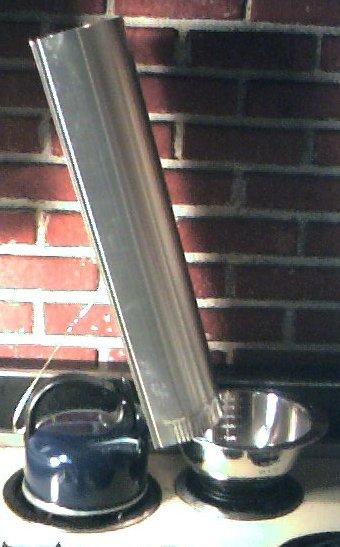
| |
 |
![]()
 Can sheet metal or large surfaces be used to distill water evaporated from an open pan etc? Answer:
Technically Yes, but practically No. If one needs a practical way to produce drinking water before one
dies of thirst this method becomes very problematic. This method will produce a small energy inefficient
amount. I was able to get about one or two drops every 10 sec by using this method, shown at right with
an open aluminum duct. It is easy to produce way too much steam and overwhelm the cooling area, which
needs to be as large as possible. If one produces too much steam it keeps the condensation area hot all
the time and thus no condensation takes place. One will not be able to regulate the source of heat in a
primitive environment thus this method could be a problem.
Can sheet metal or large surfaces be used to distill water evaporated from an open pan etc? Answer:
Technically Yes, but practically No. If one needs a practical way to produce drinking water before one
dies of thirst this method becomes very problematic. This method will produce a small energy inefficient
amount. I was able to get about one or two drops every 10 sec by using this method, shown at right with
an open aluminum duct. It is easy to produce way too much steam and overwhelm the cooling area, which
needs to be as large as possible. If one produces too much steam it keeps the condensation area hot all
the time and thus no condensation takes place. One will not be able to regulate the source of heat in a
primitive environment thus this method could be a problem.
Another big disadvantage is if the relative humidity is too low (say below 40-50%) then condensation will
evaporate before it runs off. This method then will not then work. The source of heat whether burring
wood, gas, or electrical has a tendency to produce hot dry air above the fire that will rapidly evaporate the
condensed steam. In other words one needs to transport the steam a bit away from directly above the fire
area before trying to condense it.
Sometimes it helps to slightly cap off the ends to reduce the flow, as shown below. If there are
contaminates in the surrounding air that are settling out (like volcanic ash) then this open process will allow
the distilled water to become contaminated again. Bottom line: The open-air process is the problem in this
method it introduces too many variables. After a PS in a primitive environment one needs a controllable
process that can be repeated under widely varying weather conditions.
Offered by Mike.